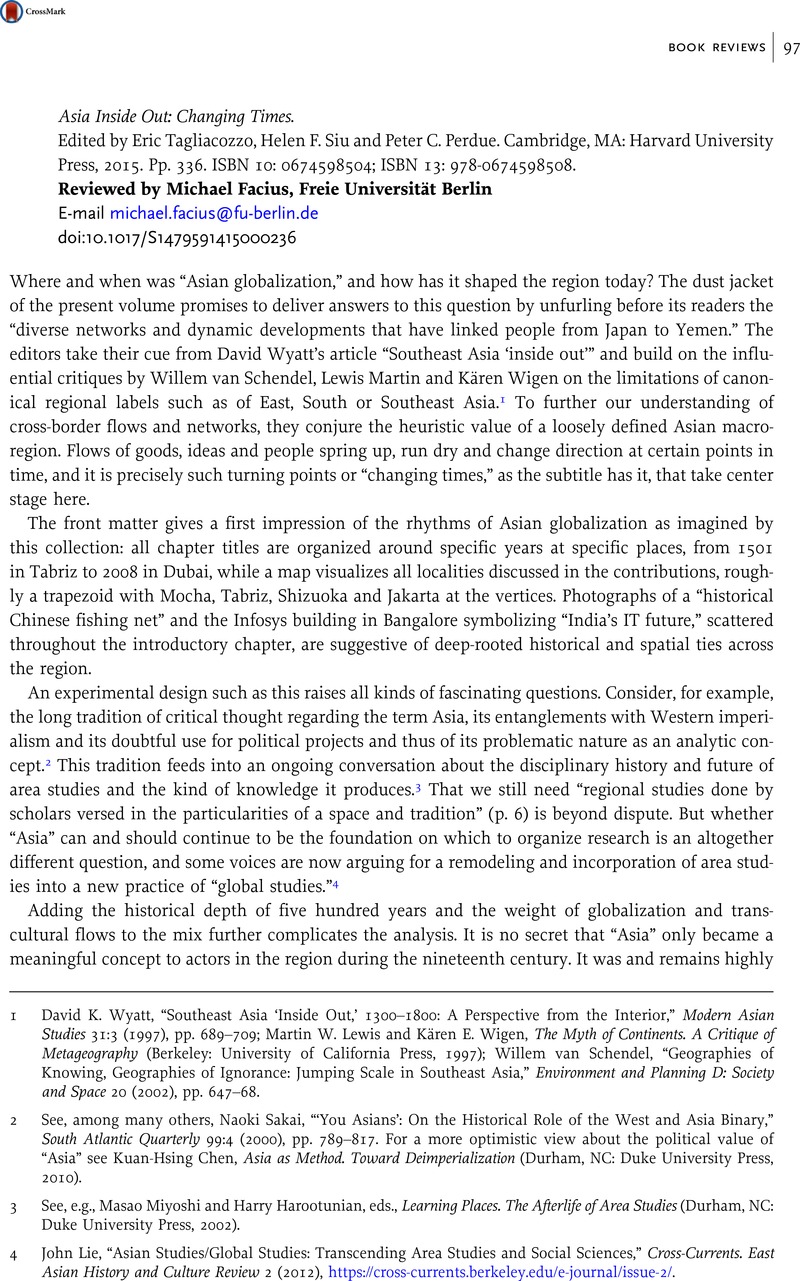No CrossRef data available.
Article contents
Asia Inside Out: Changing Times. Edited by Eric Tagliacozzo, Helen F. Siu and Peter C. Perdue. Cambridge, MA: Harvard University Press, 2015. Pp. 336. ISBN 10: 0674598504; ISBN 13: 978-0674598508.
Review products
Published online by Cambridge University Press: 13 January 2016
Abstract

- Type
- Book Reviews
- Information
- Copyright
- Copyright © Cambridge University Press 2016
References
1 Wyatt, David K., “Southeast Asia ‘Inside Out,’ 1300–1800: A Perspective from the Interior,” Modern Asian Studies 31:3 (1997), pp. 689–709CrossRefGoogle Scholar; Martin W. Lewis and Kären E. Wigen, The Myth of Continents. A Critique of Metageography (Berkeley: University of California Press, 1997); van Schendel, Willem, “Geographies of Knowing, Geographies of Ignorance: Jumping Scale in Southeast Asia,” Environment and Planning D: Society and Space 20 (2002), pp. 647–68CrossRefGoogle Scholar.
2 See, among many others, Sakai, Naoki, “‘You Asians’: On the Historical Role of the West and Asia Binary,” South Atlantic Quarterly 99:4 (2000), pp. 789–817CrossRefGoogle Scholar. For a more optimistic view about the political value of “Asia” see Kuan-Hsing Chen, Asia as Method. Toward Deimperialization (Durham, NC: Duke University Press, 2010).
3 See, e.g., Masao Miyoshi and Harry Harootunian, eds., Learning Places. The Afterlife of Area Studies (Durham, NC: Duke University Press, 2002).
4 Lie, John, “Asian Studies/Global Studies: Transcending Area Studies and Social Sciences,” Cross-Currents. East Asian History and Culture Review 2 (2012)Google Scholar, https://cross-currents.berkeley.edu/e-journal/issue-2/.
5 See Sven Saaler and Christopher W. A. Szpilman, eds., Pan-Asianism. A Documentary History, 2 vols. (Lanham: Rowman and Littlefield, 2012).
6 Victor Lieberman, Strange Parallels. Southeast Asia in Global Context, c. 800–1830, 2 vols. (New York: Cambridge University Press, 2003–9).
7 This revival has been explained by John Darwin in a similarly broad Eurasian perspective as the effect of an imperial pull following the breakup of the Timurid empire. See John Darwin, After Tamerlane: The Rise and Fall of Global Empires, 1400–2000 (London: Penguin Books, 2008).
8 Middell, Matthias and Naumann, Katja, “Global History and the Spatial Turn: From the Impact of Area Studies to the Study of Critical Junctures of Globalization,” Journal of Global History 5 (2010), pp. 149–70, here pp. 164fCrossRefGoogle Scholar.
9 Timothy Brook, Vermeer's Hat. The Seventeenth Century and the Dawn of the Global World (London: Profile Books, 2008).
10 S. Frederick Starr, Lost Enlightenment. Central Asia's Golden Age from the Arab Conquest to Tamerlane (Princeton: Princeton University Press, 2013) makes a forceful case for the inclusion of Central Asia around 1000 into any narratives about Asian globalization.
11 See, e.g., David Porter, ed., Comparative Early Modernities, 1100–1800 (New York: Palgrave Macmillan, 2012) or R. Bin Wong, “Regions and Global History,” in Writing the History of the Global, ed. Maxine Berg (Oxford: Oxford University Press, 2013), pp. 83–105.
12 Charles H. Parker, Global Interactions in the Early Modern Age, 1400–1800 (Cambridge: Cambridge University Press, 2010), p. 3.
13 On early modern Iran and its regional constellations see also the recent edited volume Willem Floor and Edmund Herzig, eds., Iran and the World in the Safavid Age (London: I. B. Tauris, 2012).
14 Matt K. Matsuda, Pacific Worlds. A History of Seas, Peoples, and Cultures (Cambridge: Cambridge University Press, 2012); Steinberg, Philip and Peters, Kimberley, “Wet Ontologies, Fluid Spaces: Giving Depth to Volume through Oceanic Thinking,” Environment and Planning D: Society and Space 33 (2015), pp. 247–64CrossRefGoogle Scholar.
15 Jiang Wu, Leaving for the Rising Sun. Chinese Zen Master Yinyuan and the Authenticity Crisis in Early Modern East Asia (Oxford: Oxford University Press, 2015).




